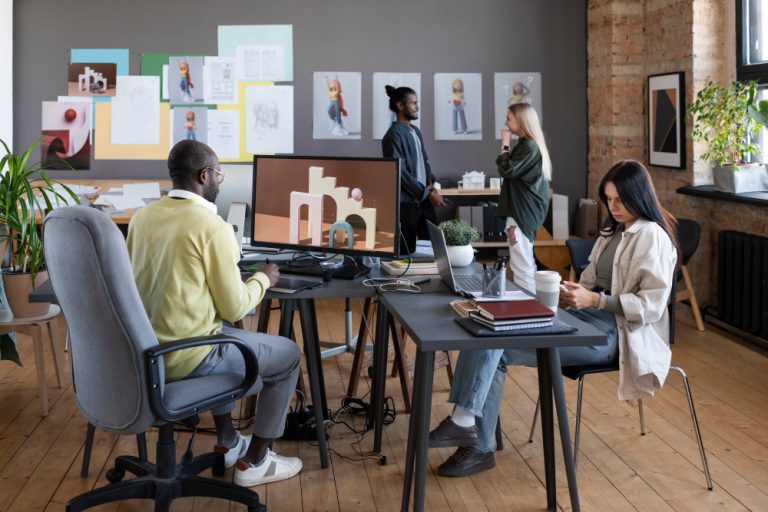2020 changed the way we work. Even after return-to-office mandates, hybrid work models are here to stay.
Bay Area tech giants and startups alike now blend in-office collaboration with remote flexibility — but this shift has exposed a design gap.
Traditional office layouts don’t work anymore.
Rows of identical desks and fixed meeting rooms fail to serve hybrid teams who split their time between home and the office.
In 2025, forward-thinking companies are tackling this challenge with office remodels built for hybrid work — combining flexible spaces, advanced technology, and employee wellness.
What Makes a Hybrid Office Different?
Hybrid offices aren’t just smaller versions of pre-pandemic spaces. They are fundamentally reimagined with three goals in mind:
- Flexibility: Spaces that transform based on daily occupancy
- Technology Integration: Seamless collaboration between remote and in-office workers
- Employee Experience: Comfort, wellness, and purpose-driven design
Key Design Trends in Hybrid Office Remodels
1. Flexible Seating & Hot Desking
Hybrid teams don’t need assigned desks every day.
Hot desking systems with mobile storage and smart booking apps maximize efficiency.
Example: San Jose startups cutting office space by 30% using flexible layouts.
2. Collaboration Zones
Open lounges and project-based rooms replace static meeting spaces.
Acoustic pods and huddle areas cater to hybrid brainstorming sessions.
3. Technology-Enhanced Meeting Rooms
Video-first setups with 360-degree cameras and AI-powered transcription bridge remote and onsite teams.
Tools like Zoom Rooms and Microsoft Teams Panels are becoming standard.
4. Quiet Focus Areas
Not every hybrid worker needs buzz — soundproof booths and focus rooms support deep work when in the office.
5. Wellness-Driven Features
Natural lighting, indoor plants, ergonomic furniture enhance mental and physical well-being.
Biophilic design is trending among Silicon Valley remodels.
Why Hybrid Remodels Are Critical for Bay Area Companies
1. Real Estate Optimization
Bay Area office rents are among the highest in the U.S. Companies like Pinterest and Dropbox reduced square footage without sacrificing productivity by rethinking layouts.
2. Talent Attraction & Retention
Hybrid-friendly offices signal flexibility and modernity, which younger professionals value highly.
A well-designed hybrid office improves recruitment and employee loyalty.
3. Cost-Efficiency with Higher ROI
Smaller footprints and shared resources lead to significant cost savings — even with upfront remodel investments.
Challenges of Hybrid Office Remodels
- Underutilized Spaces: Without good data, companies may misjudge occupancy
- Tech Gaps: Poor AV setups frustrate remote employees
- Cultural Adjustments: Hybrid success relies on policy and design alignment
Solution: Combine data analytics (occupancy sensors, surveys) with expert design-build partners who understand hybrid work trends.
Steps to Remodel for Hybrid Success
Step 1: Audit Your Current Space
Measure current utilization and identify underused zones.
Conduct employee surveys to understand hybrid pain points.
Step 2: Define Hybrid Goals
Determine balance: collaboration vs. focus, remote vs. in-office days.
Step 3: Reimagine Layouts
Plan zones: flexible seating, tech-enabled meeting rooms, quiet pods.
Step 4: Integrate Technology
Invest in AI-powered booking, smart lighting, and AV systems for seamless remote collaboration.
Step 5: Prioritize Wellness
Include natural elements, ergonomic furniture, and restorative spaces.
Step 6: Future-Proof the Space
Plan for scalability — anticipate 3-5 year growth and changing team structures.
Real-World Example: Palo Alto Tech Firm
A Palo Alto SaaS startup remodeled its 15,000 sq ft office in 2024:
- Removed 40% of fixed desks, added hot-desking zones
- Built 8 flexible collaboration rooms with AI-enabled video conferencing
- Integrated biophilic elements — green walls and daylight corridors
- Result: Employee satisfaction rose by 28%, and office energy costs dropped by 20%
Hybrid Office Remodels Are Not Optional
Hybrid work isn’t a phase — it’s the new normal.
Companies that remodel now are reaping benefits: higher productivity, happier employees, and better space utilization.
The Bay Area, with its competitive real estate and innovation culture, is the perfect testing ground for hybrid office design.
Final Thoughts
In 2025, the best offices aren’t the biggest.
They’re the smartest, most flexible, and built around how teams actually work today — anywhere, anytime.





